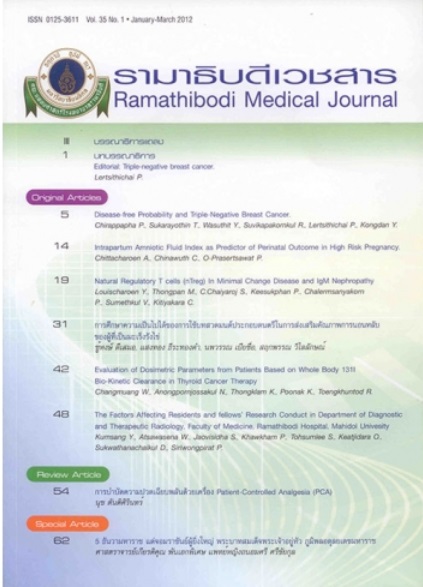การบำบัดความปวดเฉียบพลันด้วยเครื่อง Patient-Controlled Analgesia (PCA)
Keywords:
ความปวดเฉียบพลัน, เครื่อง Patient-Controlled Analgesia (PCA), การบำบัดAbstract
การบำบัดความปวดเฉียบพลันมีความสำคัญมากในเวชปฏิบัติ เนื่องจากเป็นปัญหาที่พบบ่อยแพทย์จึงควรมีความรู้ความเข้าใจถึงหลักการและวิธีการบำบัดความปวดเฉียบพลัน เพื่อสามารถบำบัดความปวดได้อย่างมีประสิทธิภาพ ส่งผลให้ผู้ป่วยมีอาการปวดน้อยลง ตลอดจนลดอาการข้างเคียงจากความปวดและความทุกข์ทรมานของผู้ป่วย
การให้ยาระงับปวดทางหลอดเลือดดำเป็นวิธีที่นิยมใช้ในการควบคุมความปวดเฉียบพลันในโรงพยาบาล เนื่องจากเป็นวิธีที่ได้ผลดี แต่การตอบสนองนั้นมีความแตกต่างอย่างมากในแต่ละบุคคล ทั้งผู้ป่วยที่มีผลข้างเคียงจากยาระงับปวดได้ง่าย เช่น หลับ หรือหายใจน้อยลง และบางกรณีผู้ป่วยต้องการยาระงับปวดปริมาณมาก จึงมีการพัฒนาวิธีการให้ยาระงับปวดโดยให้ผู้ป่วยเป็นผู้ประเมินและให้ยาระงับปวดได้ด้วยตนเอง โดยใช้เครื่อง Patient-Controlled Analgesia (เครื่อง PCA) โดยแพทย์เป็นผู้เลือกชนิดของยาระงับปวดและตั้งค่าของเครื่อง PCA
ในบทความนี้ครอบคลุมถึงหลักการบำบัดความปวดเฉียบพลัน การประเมินความปวดเฉียบพลันและวิธีการบำบัดความปวดด้วยเครื่อง PCA
References
Hauer J,Jones BL. Evaluation and management of pain in children. Available from: https://www.uptodate.com/contents/evaluation-and-management-of-pain-in-children/print. Accessed December 21, 2011.
European Society of Regional Anaesthesia and Pain Therapy (ESRA). Postoperative Pain Management -Good Clinical Practice. Sweden: European Society of Regional Anaesthesia and Pain Therapy; 2006. Available from: https://esraeurope.org/PostopertivePainManagement.pdf. December 21, 2011.
Donohoe C. History and Physical Examination of the Pain Patient. In: Waldman S, editor. Pain Management. China: Saunders Elsevier; 2007:35-48.
Australian and New Zealand College of Anaesthetists and Faculty of Pain Medicine. Acute Pain Management: Scientific Evidence. 2nd ed. Canberra: National Health and Medical Research Council; 2005.
Grass JA. Patient-controlled analgesia. Anesth Analg. 2005; 101(5 Suppl):S44-61. doi:10.1213/01.ane.0000177102.11682.20.
Macintyre PE. Safety and efficacy of patient-controlled analgesia. Br J Anaesth. 2001;87(1):36-46. doi:10.1093/bja/87.1.36.
Owen H, Plummer JL, Armstrong I, Mather LE, Cousins MJ. Variables of patient-controlled analgesia. 1. Bolus size. Anaesthesia. 1989;44(1):7-10. doi:10.1111/j.1365-2044.1989.tb11087.x.
Camu F, Van Aken H, Bovill JG. Postoperative analgesic effects of three demand-dose sizes of fentanyl administered by patient-controlled analgesia. Anesth Analg. 1998;87(4):890-5. doi:10.1097/00000539-199810000-00027.
Ginsberg B, Gil KM, Muir M, Sullivan F, Williams DA, Glass PS. The influence of lockout intervals and drug selection on patient-controlled analgesia following gynecological surgery. Pain. 1995;62(1):95-100. doi:10.1016/0304-3959(94)00255-d.
Ittichaikulthol W. Clinical Guidance for Management of Acute Postoperative Pain Management. Bangkok: Thai Association for The Study of Pain; 2011:9-14.
Macintyre PE, Schug SA. Acute Pain Management: A Practical Guide. 3rd ed. China; Saunders Elsevier; 2008:139-63.
Schug S, Grandham N. Opioids: Clinical Use. In: McMahon S, Koltzenburg M, eds. Wall and Melzack's Textbook of Pain. 5th ed. Churchill Livingstone: Saunders Elsevier; 2006:443-57.
Gan TJ, Meyer T, Apfel CC, Chung F, Davis PJ, Eubanks S, et al. Consensus guidelines for managing postoperative nausea and vomiting. Anesth Analg. 2003;97(1):62-71. doi:10.1213/01.ane.0000068580.00245.95.
Librach SL, Squires BP. The Pain Manual: Principles and Issues in Cancer Pain Management. Toronto: Pegasus Healthcare International; 1999:63-72.













